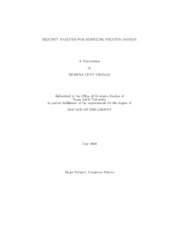| dc.description.abstract | Protein structure and motion plays an essential role in nearly all forms of
life. Understanding both protein folding and protein conformational change can
bring deeper insight to many biochemical processes and even into some devastating
diseases thought to be the result of protein misfolding. Experimental methods are
currently unable to capture detailed, large-scale motions. Traditional computational
approaches (e.g., molecular dynamics and Monte Carlo simulations) are too expensive
to simulate time periods long enough for anything but small peptide fragments.
This research aims to model such molecular movement using a motion framework
originally developed for robotic applications called the Probabilistic Roadmap
Method. The Probabilistic Roadmap Method builds a graph, or roadmap, to model
the connectivity of the movable object?s valid motion space. We previously applied
this methodology to study protein folding and obtained promising results for several
small proteins.
Here, we extend our existing protein folding framework to handle larger proteins
and to study a broader range of motion problems. We present a methodology for
incrementally constructing roadmaps until they satisfy a set of evaluation criteria.
We show the generality of this scheme by providing evaluation criteria for two types
of motion problems: protein folding and protein transitions. Incremental Map Generation
eliminates the burden of selecting a sampling density which in practice is highly
sensitive to the protein under study and difficult to select. We also generalize the roadmap construction process to be biased towards multiple conformations of interest
thereby allowing it to model transitions, i.e., motions between multiple known
conformations, instead of just folding to a single known conformation. We provide
evidence that this generalized motion framework models large-scale conformational
change more realistically than competing methods.
We use rigidity theory to increase the efficiency of roadmap construction by introducing
a new sampling scheme and new distance metrics. It is only with these
rigidity-based techniques that we were able to detect subtle folding differences between
a set of structurally similar proteins. We also use it to study several problems
related to protein motion including distinguishing secondary structure formation order,
modeling hydrogen exchange, and folding core identification. We compare our
results to both experimental data and other computational methods. | en |


